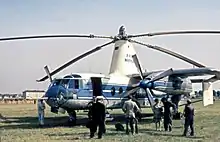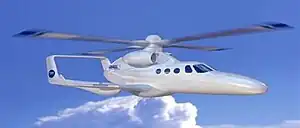Gyrodyne
A gyrodyne is a type of VTOL aircraft with a helicopter rotor-like system that is driven by its engine for takeoff and landing only, and includes one or more conventional propeller or jet engines to provide forward thrust during cruising flight. During forward flight the rotor is unpowered and free-spinning, like an autogyro (but unlike a compound helicopter), and lift is provided by a combination of the rotor and conventional wings. The gyrodyne is one of a number of similar concepts which attempt to combine helicopter-like low-speed performance with conventional fixed-wing high-speeds, including tiltrotors and tiltwings.
In response to a Royal Navy request for a helicopter, Dr. James Allan Jamieson Bennett designed the gyrodyne whilst serving as the chief engineer of the Cierva Autogiro Company. The gyrodyne was envisioned as an intermediate type of rotorcraft, its rotor operating parallel to the flightpath to minimize axial flow with one or more propellers providing propulsion. Bennett's patent covered a variety of designs, which has led to some of the terminology confusion – other issues including the trademarked Gyrodyne Company of America and the Federal Aviation Administration (FAA) classification of rotorcraft.
In recent years, a related concept has been promoted under the name heliplane. Originally used to market gyroplanes built by two different companies, the term has been adopted to describe a Defense Advanced Research Projects Agency (DARPA) program to develop advances in rotorcraft technology with the goal of overcoming the current limitations of helicopters in both speed and payload.
Principles of operation
Where a conventional helicopter has a powered rotor which provides both lift and forward thrust, and is capable of true VTOL performance, a gyroplane or autogyro has a free-spinning rotor which relies on independent powered thrust to provide forward airspeed and keep it spinning. The gyrodyne combines aspects of each. It has an independent thrust system like the autogyro, but can also drive the rotor to allow vertical takeoff and landing; it then changes to free spinning like an autogyro during cruising flight.[1][2]
In the helicopter, the spinning rotor blades draw air down through the rotor disc; to obtain forward thrust, the rotor disc tilts forward so that air is also blown backwards. In the autogyro the rotor disc is by contrast tilted backwards; as the main thrust drives the craft forwards, air flows through the rotor disc from below, causing it to spin and create lift. The gyrodyne is capable of transitioning between these two modes of flight.
Typically a gyrodyne also has fixed wings which provide some of the lift during forward flight, allowing the rotor to be offloaded. A computer simulation has suggested an optimum distribution of lift of 9% for the rotor, and 91% for the wing.[3] However if the rotor is too lightly loaded it can become susceptible to uncontrolled flapping.[4]
History
In Britain, Dr. James Allan Jamieson Bennett, Chief Engineer of the Cierva Autogiro Company, conceived an intermediate type of rotorcraft in 1936, which he named "gyrodyne" and which was tendered to the British Government in response to an Air Ministry specification. In 1939, Bennett was issued a patent from the UK Patent Office, assigned to the Cierva Autogiro Company. On 23 August 1940 the Autogiro Company of America, licensees of the Cierva Autogiro Company, Ltd., filed a corresponding patent application in the United States. On 27 April 1943, US patent #2,317,340 was issued to the Autogiro Company of America. The patents describe a gyrodyne as:
a rotary wing aircraft intermediate in type, hereinafter referred to as "gyrodyne", between a rotaplane (with the rotor free for autorotation and an upward total axial flow through the rotor disc), on the one hand, and a pure helicopter (with the rotor driven, and a downward total axial flow through the rotor disc), on the other hand, that is with a mean axial flow through the rotor disc substantially zero at high forward speed.[5]
Bennett's concept described a shaft-driven rotor, with anti-torque and propulsion for translational flight provided by one or more propellers mounted on stub wings. With thrust being provided by the propellers at cruise speeds, power would be provided to the rotor only to overcome the profile drag of the rotor, operating in a more efficient manner than the freewheeling rotor of an autogyro in autorotation. Bennett described this flight regime of the gyrodyne as an "intermediate state", requiring power to be supplied to both the rotor and the propulsion system.
Early development
The Cierva Autogiro Company, Ltd's, C.41 gyrodyne pre-WW2 design study was updated and built by Fairey Aviation as the FB-1 Gyrodyne commencing in 1945. Fairey's development efforts were initially led by Bennett, followed by his successor Dr. George S. Hislop. George B.L. Ellis and Frederick L. Hodgess, engineers from the pre-WW2 Cierva Autogiro Company, Ltd., joined Bennett at Fairey Aviation. The first Fairey Gyrodyne prototype crashed during a test flight, killing the crew. The second Gyrodyne prototype was rebuilt as the Jet Gyrodyne and used to develop a pressure-jet rotor drive system later for the Rotodyne transport compound gyroplane. At the tip of each stub wing were rearward-facing propellers which provided both yaw control and propulsion in forward flight. The Jet Gyrodyne flew in 1954, and made a true transition from vertical to horizontal flight in March 1955.

This led to the prototype Fairey Rotodyne, which was developed to combine the efficiency of a fixed-wing aircraft at cruise with the VTOL capability of a helicopter to provide short haul airliner service from city centres to airports. It had short wings that carried two Napier Eland turboprop engines for forward propulsion and up to 40% of the aircraft's weight in forward flight. The rotor was driven by tip jets for takeoff and landing and translational flight up to 80 mph. Despite considerable commercial and military interest worldwide in the prototype Type Y Rotodyne for air transport, British orders were not forthcoming and British Government financial support was terminated in 1962. The division's new parent Westland Helicopters did not see good cause for further investment and the project was stopped. With the end of the Fairey Aviation programs, gyrodyne development came to a halt, although several similar concepts continued to be developed.
Similar developments
In 1954, the McDonnell XV-1 was developed as a rotorcraft with tip jets to provide vertical takeoff capability. The aircraft also had wings and a propeller mounted on the rear of the fuselage between twin tailbooms with two small rotors mounted at the end for yaw control. The second prototype of XV-1 became the world's first rotorcraft to exceed 200 mph in level flight on 10 October 1956. No more were built and the XV-1 project was terminated in 1957.
Compound autogyro
In 1998, Carter Aviation Technologies successfully flew its technology demonstrator aircraft. The aircraft is a compound autogyro with a high-inertia rotor and wings optimized for high-speed flight. In 2005, the aircraft demonstrated flight at mu-1, with the rotor tip having airspeed equal to the aircraft's forward airspeed, without any vibration or control issues occurring. The high-inertia rotor allowed the aircraft to hover for a brief moment during landing, even though the rotor is unpowered, and a prerotating gearbox allows the rotor to be accelerated for an autogyro-style jump takeoff.
Heliplane
In 1954, KYB built an aircraft named the Heliplane. The Heliplane was a Cessna 170B with the wings reduced to stubs, and a rotor powered by tip ramjets.

DARPA was funding a project under the "Heliplane" name to develop the gyrodyne concept around 2007.[6][7] Aircraft developed for the project would use a rotor for takeoff and landing vertically, and hovering, together with substantial wings to provide most of the required lift at cruise, combining the large cargo capacity, fuel efficiency, and high cruise speed of fixed-wing aircraft with the hovering capabilities of a helicopter. The project was "…a multi-year $40-million, four-phase program. Groen Brothers Aviation is working on phase one of that program, a 15-month effort… (it) combines the "gyroplane"… with a fixed-wing business jet. The team was using the Adam A700, in the very-light-jet class…"[8] There were issues with tip jet noise, and the program was cancelled in 2008.[9]
An industry magazine describes the gradual evolution of traditional helicopters as "slow" and lacking revolutionary steps, and non-traditional compounds are still not widespread.[10]
Trademark
"Gyrodyne" was granted as a trademark to the Gyrodyne Company of America in 1950.[11] The company was not involved in gyrodyne development, but instead produced a turbine-engined, remotely piloted drone helicopter, with coaxial rotors, for the United States Navy, designated as the QH-50 DASH.
Examples
- Fairey FB-1 Gyrodyne
- Fairey Jet Gyrodyne
- Fairey Rotodyne (1957)
- Flettner Fl 185
- Kamov Ka-22 (1959)
- Kayaba Heliplane (Japan)
- McDonnell XV-1
References
Notes
- Rotorcraft Flying handbook: For Gyroplane Use Only, FAA-H-8083-21 FAA, 2000. "The 'gyrodyne' is a hybrid rotorcraft that is capable of hovering and yet cruises in autorotation. The first successful example of this type of aircraft was the British Fairy Rotodyne, certificated to the Transport Category in 1958. During the 1960s and 1970s, the popularity of gyroplanes increased with the certification of the McCulloch J-2 and Umbaugh. The latter becoming the Air & Space 18A."
- Electronic Code of Federal Regulations (e-CFR) Title 14. Aeronautics and Space Chapter I. FEDERAL AVIATION ADMINISTRATION, DEPARTMENT OF TRANSPORTATION Subchapter A. DEFINITIONS AND GENERAL REQUIREMENTS Part 1. DEFINITIONS AND ABBREVIATIONS, Section 1.1. General definitions. Legal Information Institute, Cornell Law School. (retrieved 4 April 2020). "Gyrodyne means a rotorcraft whose rotors are normally engine-driven for takeoff, hovering, and landing, and for forward flight through part of its speed range, and whose means of propulsion, consisting usually of conventional propellers, is independent of the rotor system."
- Yeo, Hyeonsoo; Johnson, Wayne. "Optimum Design of a Compound Helicopter Archived 2014-06-01 at the Wayback Machine" page T111-3-4. ADA517226 Direct link, 1MB
- H.A. Taylor; Fairey Aircraft Since 1915, Putnam, 1974, p.408.
- Bennett, James A.J. U.S. Patent 2,317,340: Helicopter. 27 April 1943. Retrieved on 26 August 2009.
- Department of Defense Fiscal Year (FY) 2008/2009 Budget Estimates, DARPA, February 2007, p. 239, archived from the original on 2014-10-09.
- Heliplane, Tactical Technology Office, Defense Advanced Research Projects Agency, retrieved 27 August 2009.
- McKenna, James T (February 2007), "One Step Beyond", Rotor & Wing, p. 54.
- "Darpa takes another shot at High-Speed VTOL", Aviation Week & Space Technology, 26 February 2013, retrieved 2 August 2014.
- McKenna, James T (August 2007), "40 Years Retrospective: Power and Vision", Rotor & Wing, Aviation today, archived from the original on 21 May 2014, retrieved 8 June 2014.
- US trademark 71571611
Bibliography
- "The Fairey Gyrodyne." J.A.J. Bennett. Journal of the Royal Aeronautical Society, 1949, Vol. 53
- "Aerodynamics of the Helicopter". Alfred Gessow & Garry C. Myers, Jr. Frederick Ungar Publishing Company, NY. 1952, republished 1962.
- "Principles of Helicopter Aerodynamics". J. Gordon Leishman, Cambridge University Press, N.Y. 2000, reprinted 2005.
- "Principles of Helicopter Engineering". Jacob Shapiro, Temple Press Ltd., London, 1955.
- "Development of the Autogiro: A Technical Perspective": J. Gordon Leishman: Hofstra University, New York, 2003.
- From Autogiro to Gyroplane: The Amazing Survival of an Aviation Technology: Bruce H. Charnov, 2003.
External links
- VSTOL.org Wheel of Misfortune
- Charnov, Bruce H. The Fairey Rotodyne: An Idea Whose Time Has Come – Again?
- Gyrodyne and Heliplane concepts (2005)
- Heliplane concept
- Jet Gyrodyne (1954)
- Hirschberg, Mike (with Robb, Raymond L.) Hybrid helicopters: Compounding the quest for speed, Vertiflite. Summer 2006. American Helicopter Society.
- Newman, Simon. The Compound Helicopter Configuration and the Helicopter Speed Trap Aircraft Engineering and Aerospace Technology. 69(5): pp 407–413

